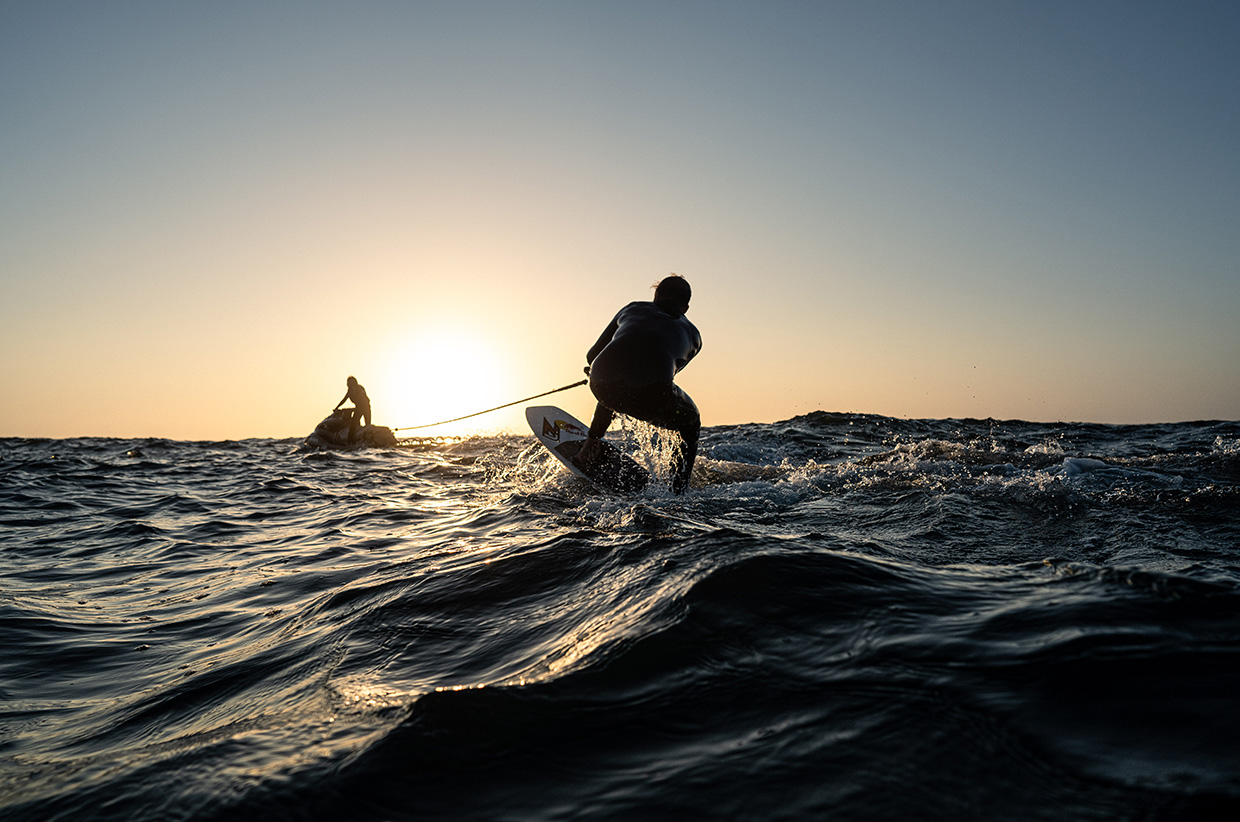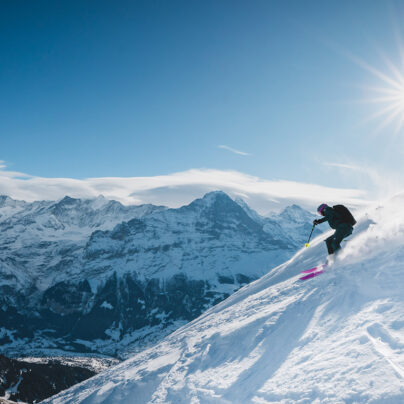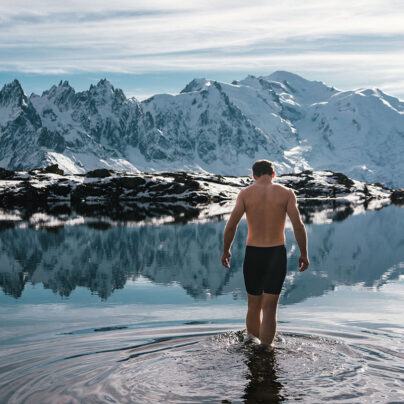Soul Hunger
Story by Andrew Cotton // Written by Tom Hill
Photography by Matt Pycroft, Helio Antonio & Luis Pereira
Andrew Cotton shares his big-wave story, overcoming fears and injury, his relationship with Nazaré, and finding happiness through his connection with the ocean.
It would be hard to design a location more suited to big-wave surfing than Nazaré, Portugal. The big waves here are beautiful and mind boggling. With the whole Atlantic unimpeded at its doorstep, Nazaré has the geography nailed – and geology is in its favour too. Extending out to sea for 160 miles from the shore is a deep underwater canyon that was etched out by an ancient river when sea levels were much lower than today. At times the canyon is up to three miles deep and gives the waves an almost unimpeded run as they propagate towards the shore, refracting them towards the centre of the canyon, at the end of which is Praia do Norte (North Beach): home of the largest waves ever surfed.
It’s the tail end of summer and I’m looking out over an altogether calmer ocean. The lighthouse above the cliffs overlooking Praia do Norte is almost as iconic as the waves it regularly watches over. It gives a sense of scale to the waves, more than 90ft in height, which pummel the coastline a few times each winter; it also acts as a viewing point for the few who watch on, squinting into sea spray trying to pick out surfers amongst the chaos of crashing waves.
It was the scale of the waves that first drew me to Nazaré. And I guess you could say that my life story, certainly my professional career – although I still sometimes find it hard to believe that I am a pro surfer – is entwined with the rebirth of the old Portuguese fishing village as a big-wave destination.


Back in 2010, I was a plumber. I’d reached the point where I needed an out, needed a way to follow my passion and simply surf. I was away in Ireland, catching big waves on the west coast, when I got a call from Garrett McNamara. The Hawaiian was – and still is – one of the best-known professional big-wave surfers in the world.
We’d never met, but he was coming to Europe to try and surf this place called Nazaré and needed some support. Big-wave surfing almost always relies on jet skis, either to act as a tow-in (the waves travel so quickly that it’s the only way to match their speed) or just as a safety vessel should the worst happen. I happened to be decent on a jet ski, so I think that’s partly why I got the call. No-one had even heard of Nazaré, but when it’s Garrett McNamara, you make the trip. It ended up completely changing my life.
It was after just three days that I saw my first big wave here, and I knew then that this needed to be my life. There was a period between 2010 and 2013 when it was just me, Garrett, and Al Mennie in this big-wave Disneyland. Clean, giant peaks and no-one about.
‘No-one had even heard of Nazaré, but when it’s Garrett McNamara, you make the trip. It ended up completely changing my life.’
McNamara set the world record in Nazaré in 2012, and I operated his jet-ski support that day. It changed the way the world saw Nazaré and thrust big-wave surfing into the attention of the global media. It was possibly also that day that fully set me on my current path. By following my instincts, I’d discovered a corner of the surfing world and finally immersed myself completely.
So much of big-wave surfing is about instinct. Forget the training and conditioning and years of experience for a moment. Put aside the guts and self-confidence. Listen to the voice inside, and make a judgement. Some days it says no. Other days you just know. Then there are the times when you just go for it anyway.
I think my happiest moments have been when I get to a point where I just want to pull the pin. You are ready to say ‘I’m not gonna do it’ and the pressure or the anxiety are almost a breaking point. And then you push past it, and you come out on the other side thinking Thank God, I did it. Thank God I didn’t give up. That is when I’m at my happiest.



But, in 2017, everything changed again for me – and this time not for the better.
***
Water feels more like reinforced concrete than liquid as I land from 30ft up in the air. I am catapulted up and out of the wave moments after I bail into it. My back slams into the water first as I impact the sea in a foetal position. It’s strange, but I feel almost completely calm. The pain surges through me as I am engulfed by the storm of turbulent water.
Lifetimes seem to pass while you are held down by a wave. You lose any sense of up or down. Seconds feel like minutes, but you just have to trust that you’ll crest the surface. I have time for a breath or two before another mountain of water breaks over my head, a skyscraper collapsing all around me.
When eventually I get towed to the beach by the jet ski, I know that it is bad. Already I know that my back is broken – I can feel pins and needles down my right side. The crew slide me onto a backboard and put a neck brace around me while we wait for an ambulance. So I lie there, staring up, and all I can think about is calculating how long it might be before I can get back in the water.
***
It took seven months for me to recover from the smashed L2 vertebra I sustained in 2017, and even longer for me to be able to surf big waves again. But I returned. I get asked why and how a lot, but these weren’t really questions I asked myself. There are times when I am content just enjoying smaller waves, and then I almost feel like I don’t need anything else. But the draw of going big is too strong. It’s like I am on a runaway train, and I’m not sure that I’m ready to get off the train yet. The end goal is always to surf the biggest wave ever. That’s all it can be.
I’m still coming to terms with it. I don’t think I’ll ever 100 per cent admit it. There are times when all I want is to be on every big swell, catch a couple of waves and enjoy time in the ocean. Why am I putting my body on the line for this goal of surfing the biggest wave? Why does it even matter anyway? Ultimately all I really want is to enjoy the ocean, push boundaries, and have fun. Setting the biggest wave as a target is just a way to keep me pushing harder.



Why does the biggest wave attract me so much? To understand it, I think about what may be the smallest wave I’ve ever caught: my first. It provides contrast, or maybe it’s the opposite. It gives me meaning: the reason I surf big, the reason I keep chasing the dream, the reason I don’t want to get off the pro-surf train just yet. I remember the first wave I ever caught so vividly, remember the buzz I got from it. That’s all I am ever chasing now. The same buzz as that first time.
My first surfing memories are from North Devon. One Easter, my dad took me surfing – rented me a board and a wetsuit from Saunton car park. It was freezing cold. He sat in the car reading his paper and I just took myself off and got freezing cold in the sea by myself. I was happy. I loved it. I did other sports as a kid, but I hated being constrained by rules. I loved just being in the sea and just working it all out for myself with no-one telling me what to do.
I originally started foiling because I thought that’s how I’d surf the biggest wave in the world, but also because, just like the kid who didn’t like being constrained by rules, I’m intrigued by the freedom offered by foiling. It’s a different rulebook. Some people don’t see it as proper surfing – there are differences, and foiling is hard to explain. It feels almost like snowboarding or skateboarding. You are connected to the board, using your weight and hips a lot more, and as a result you feel connected to the sea. You end up travelling something like three times as fast and it feels like you are flying, joining up these lumps of energy, drawing lines on waves that simply aren’t possible on a paddleboard. So while it might not quite be surfing, the sensation you get is 100 per cent surfing.
On the biggest days it’s sometimes hard to go fast enough on a surfboard. It’s just so bumpy. Because the foil raises the board out of the water it smoothes things out. Maybe, I thought, a foil would be better on those big days – but then I realised how hard it is! The best guys make it look super easy and flowy, but it’s so difficult to achieve that. Still, I love the learning process.
‘The ocean is so scary. To be in the middle of something that scary and find some flow, even for a little bit, is magic.’
For now, I still use my surfboard for the biggest days, but I love foiling in smaller swells. On days like today, with neat sets of rollers languidly drifting in, it’s ideal. It makes you look at the ocean in a different way. There’s no fear, no obvious danger or peril, only pure enjoyment and a chance to connect with the natural elements of my surroundings: sea, sky, the dynamic power of the waves, and all facilitated by a form of technology so light in its footprint that it feels almost like magic.



Big-wave surfing is about testing yourself physically, mentally, and in the end I think it’s a mind game. You’re putting yourself in a position that no sane person would want to be in. The ocean is so scary. To be in the middle of something that scary and find some flow, even for a little bit, is magic. It’s not as if you are conquering it or anything like that – you are just getting to experience it in a way that no-one else does. Seeking out what you thrive on. So you test it, push it. Every now and then, you push it too far and you take it. We are all learning as we go along. I think that’s precisely why I love it – surfing big waves feeds the hunger I feel in my soul.
Further Reading:
Going Big – An Interview with Andrew Cotton
Making Waves – In Conversation with Matt Pycroft
Story by Andrew Cotton // @andrew_cotty
Written by Tom Hill // @24Tom
Photography by Matt Pycroft // @mattpycroft, Helio Antonio // @helio_antonio & Luis Pereira // @lhpereira
Film by Coldhouse // @coldhouse_
Produced in partnership with Porsche // @porsche





